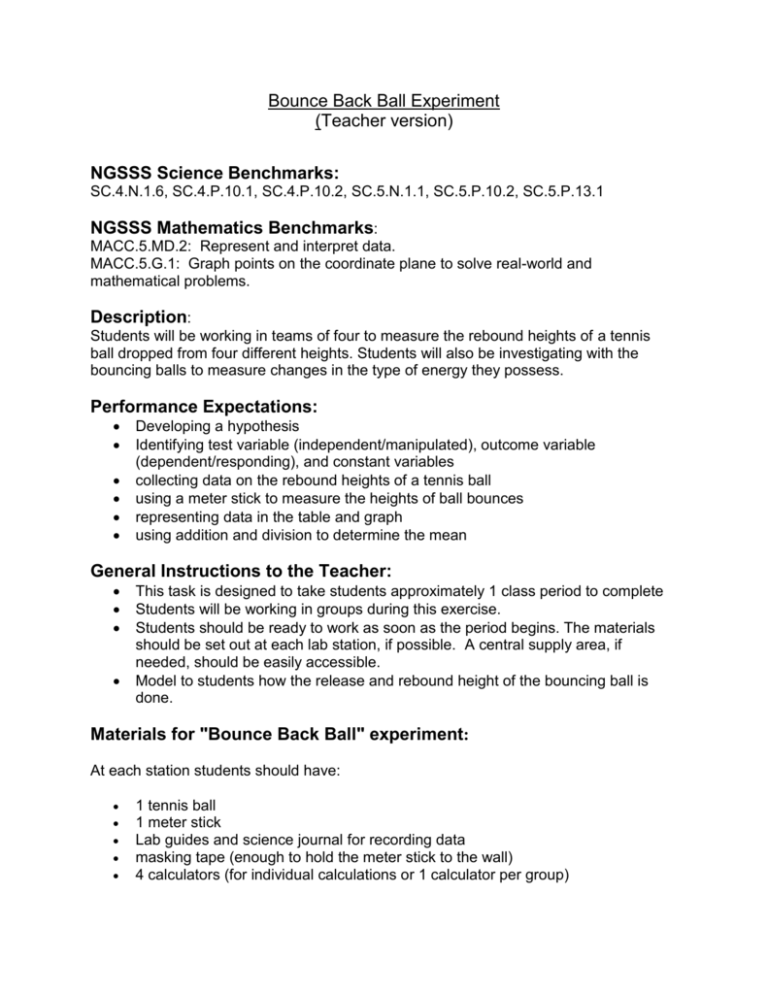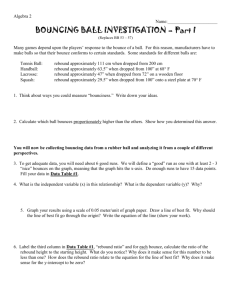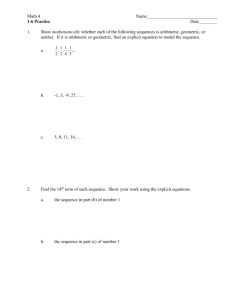Bounce Back Ball Experiment
advertisement

Bounce Back Ball Experiment (Teacher version) NGSSS Science Benchmarks: SC.4.N.1.6, SC.4.P.10.1, SC.4.P.10.2, SC.5.N.1.1, SC.5.P.10.2, SC.5.P.13.1 NGSSS Mathematics Benchmarks: MACC.5.MD.2: Represent and interpret data. MACC.5.G.1: Graph points on the coordinate plane to solve real-world and mathematical problems. Description: Students will be working in teams of four to measure the rebound heights of a tennis ball dropped from four different heights. Students will also be investigating with the bouncing balls to measure changes in the type of energy they possess. Performance Expectations: Developing a hypothesis Identifying test variable (independent/manipulated), outcome variable (dependent/responding), and constant variables collecting data on the rebound heights of a tennis ball using a meter stick to measure the heights of ball bounces representing data in the table and graph using addition and division to determine the mean General Instructions to the Teacher: This task is designed to take students approximately 1 class period to complete Students will be working in groups during this exercise. Students should be ready to work as soon as the period begins. The materials should be set out at each lab station, if possible. A central supply area, if needed, should be easily accessible. Model to students how the release and rebound height of the bouncing ball is done. Materials for "Bounce Back Ball" experiment: At each station students should have: 1 tennis ball 1 meter stick Lab guides and science journal for recording data masking tape (enough to hold the meter stick to the wall) 4 calculators (for individual calculations or 1 calculator per group) Advance Preparation: Prior to testing, familiarize yourself with the teacher demonstration. Tape a meter stick to the wall so 0 cm is on the floor and 100 cm is at the top. Be sure that the students will be able to see the stick when they are viewing the demonstration as a group. Write the following definitions on the chalkboard: Energy-the ability to do work Mechanical Energy can be classified as; o Energy of position: Is the energy that is stored in an object by its position or chemical composition o Energy of Motion: Is the energy of matter in motion Plan to assign students to groups of four. Assign each student a number from 1-4. If you do not have four students in a group, students may double up on assignment. Write the following student assignments on the chalkboard: o Student One will be the taper: Your job is to tape the meter stick to the wall or any stable vertical surface o Student Two will be the dropper: Your job is to drop the ball o Student Three will be the spotter: Your job is to sit on the floor and take the measurement carefully, looking straight at the meter stick o Student Four will be the recorder: Your job is to record the measurements . References: Modified and adapted from CPALMS and Discovery resources http://www.cpalms.org/RESOURCES/URLresourcebar.aspx?ResourceID=wyXINsSsSf8=D http://pals.sri.com/tasks/5-8/BounceBall/directs.html Discovery Resource: How Scientists work series: What is the Scientific Method: Ball Bounce Bounce Back Ball Experiment (Student version) Group Members: _______________________________________________________ ________________________________________________________ ________________________________________________________ Description: You will be working in teams of four to measure the rebound heights of a tennis ball dropped from four different heights. You will be investigating with the bouncing balls to measure changes in the type of energy they possess. Materials per group: 1 tennis ball 1 meter stick Science journal and lab sheet for recording data masking tape (enough to hold the meter stick to the wall) 4 calculators or 1 calculator per group Directions: Each team member will have a job to do based on a number: 1, 2, 3, or 4. Number 1: Tape the meter stick to the wall or any stable vertical surface with 0 cm at the bottom. Number 2: Drop the tennis ball from each of the different heights three times as shown on the chart. Number 3: Take the measurement of the rebound. Be sure to use the bottom edge of the ball for your measurements. You should sit on the floor directly in front of the meter stick and be ready to watch the ball bounce. Number 4: Record the data. Make sure other team members copy the data into their Science Journal after all data is collected. Problem Statement: Does the height that a rubber ball is dropped from affect its bounce height? Hypothesis: Make a prediction as to what you think will happen to the height of a bounce if a rubberball is dropped from different heights. Example: If the ball is dropped from _____ cm, then the bounce height will be ____cm. Variables: What would be your test variable (independent/manipulated)? What would be your outcome variable (dependent/responding)? Constant variables: _____________________________________________ Activity: 1. Conduct the trials and have the recorder complete the "Ball Rebound Heights" chart. When you have completed all of the trials, each of you should copy the data onto your own charts. Ball Rebound Heights Starting Height Trial 1 Trial 2 Trial 3 Average 100 cm 80 cm 60 cm 40 cm 2. Suppose that one of your classmates had stated that a ball will not bounce back to the starting height no matter what the starting position might be. Using evidence from you investigation, explain whether or not you think your classmate's statement was true. _____________________________________________________________ _____________________________________________________________ _____________________________________________________________ _____________________________________________________________ 3. Construct a graph that illustrates the mean rebound height for each drop height as calculated in Step 1. Use DRY MIX criteria for graphing (DRY, D=dependent variable, or R= responding variable should go on the Y axis. MIX (M= manipulated variable or I = independent variable goes on X-axis) Y X 4. In this investigation, you measured the starting height and the rebound height of the ball. Now let's look at the type of energy the ball had at different times. . STEP 1: Identify the kind of energy the ball had when you held the ball at 100 cm.? ______________________________________________ STEP 2: Explain your answer. _________________________________________________________ __________________________________________________________ _________________________________________________________ STEP 3: Identify the kind of energy when the ball was released. Explain your answer __________________________________________________________ __________________________________________________________ 5. ________________________________________________________ Suppose the rebound height of a ball was 80 cm when its starting height was 100 cm. Explain what caused the difference in the amount of energy in the ball. ________________________________________________________________ ________________________________________________________________ Conclusion: Answer the following questions: 1. What was investigated? (State the purpose of the experiment by describing the problem statement.) ___________________________________________________________________ ___________________________________________________________________ ___________________________________________________________________ ___________________________________________________________________ 2. Was your hypothesis supported by the data? (Write a statement as to whether the data supports or does not support the hypothesis including a restatement of the hypothesis.) ___________________________________________________________________ ___________________________________________________________________ ___________________________________________________________________ ___________________________________________________________________ 3. What were the major findings? (Describe the data collected that provides the evidence as to why the hypothesis was supported or not supported.) ___________________________________________________________________ ___________________________________________________________________ ___________________________________________________________________ ___________________________________________________________________ 4. What possible explanations can you offer for your findings? (Think about everything that may have affected your results.) ___________________________________________________________________ ___________________________________________________________________ ___________________________________________________________________ ___________________________________________________________________ ___________________________________________________________________ Application: Answer the following questions: 1. How can the investigation be improved? ___________________________________________________________________ ___________________________________________________________________ ___________________________________________________________________ ___________________________________________________________________ ___________________________________________________________________ 2. What are some possible applications of the experiment? (Describe how the findings from this investigation can be used in day-to-day life.) ___________________________________________________________________ ___________________________________________________________________ ___________________________________________________________________ ___________________________________________________________________ ___________________________________________________________________ 3. What questions has your experiment lead you to ask that could be tested in a new an investigation. ___________________________________________________________________ ___________________________________________________________________ ___________________________________________________________________ ___________________________________________________________________ ___________________________________________________________________ Enrichment / Extension Activity: A researcher conducted a similar experiment using rubber-ball and was able to develop a mathematical equation from his results. He found that Y = 3/4 X, where X represents the dropped heights and Y represents the bounce heights. Since 3/4 is equal to 75%, then one can conclude that the bounce height is about 75% of the dropped height. From the class data you collected in this experiment, could you develop a mathematical equation?






